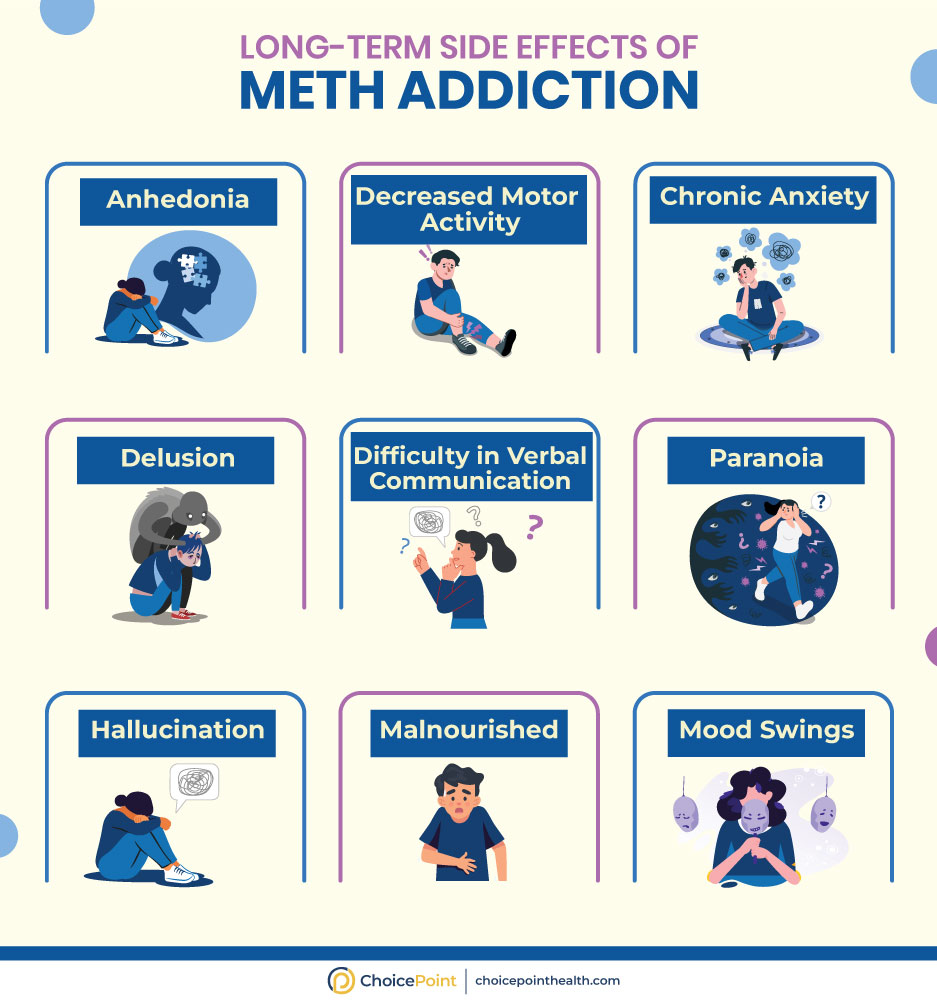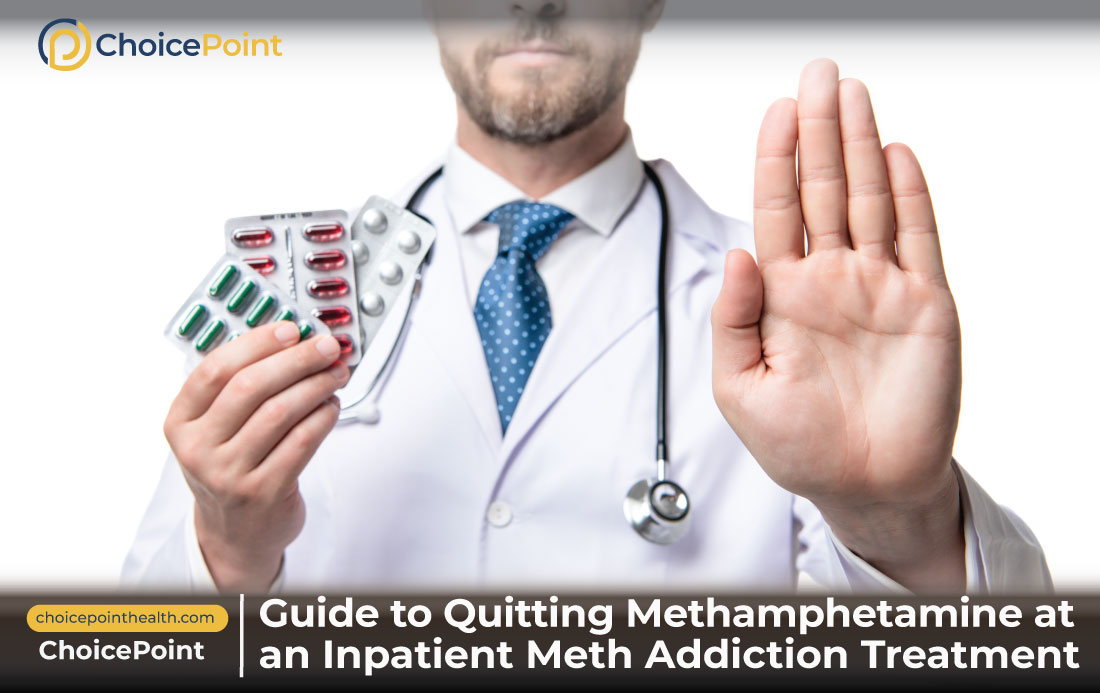Meth overdose in 2021 skyrocketed to 53,400 in the United States. Raising alarms among people for its potent nature and associated highly fatal consequences. Stimulant abuse (meth) is among the top misused drugs in the United States. An inpatient meth addiction treatment addresses all concerns related to meth addiction, overdose, and potential side effects that could be avoided through professional help.
ChoicePoint inpatient rehab provides all stimulant abuse addiction treatment, including meth. Get in touch to know how we can help 844.445.2563.
Table of Contents
Ice Vs Meth: Know the Difference
Meth is a common name for methamphetamines, usually found in three forms
- Ice (Crystal meth) A crystalized form of meth with high potency
- Speed (powder meth) is a white powdered form with less intensity
- Base (yellowish big chunks of meth or powder having a moderate level of potency)
All of these forms fall under psychostimulants and have different side effects and complications if abused.
Methamphetamine Vs Amphetamines
Both drugs are generally the same and fall under the Schedule II category of DEA. Still, the main differences arise in the type, as meth is a synthetic form, whereas amphetamines are generally natural derivates. Amphetamines have lower potency than methamphetamine and are prescribed for brain disorders such as (ADHD) and narcolepsy.
Commonly prescribed Amphetamines include:
- Adderall
- Dexedrine
- Vyvanse
Whereas, typical street names for meth include:
- Glass
- Speed
- Ice
- Crystal
- Crank
- Tweak
- Redneck Cocaine
- Chalk
No matter what form of meth a person uses. It is a highly addictive substance with lots of potential side effects and must be used under strict professional considerations.
 Did You Know:In 2023, 34,000 deaths were due to meth overdose and addiction!
Did You Know:In 2023, 34,000 deaths were due to meth overdose and addiction!
Methamphetamine Addiction: Why is it So Addictive?
Meth is a highly addictive substance due to its CNS activity and pleasure effects that lead to higher desires and cravings for the substance. Smoking, snorting, or injecting it for recreational use causes severe addiction, showing signs such as:
- Spending more time acquiring drugs
- Social anxiety and behavioral issues
- Work/college life impairment
No matter whether it is used as a prescription medication or for recreational purposes, it is a highly addictive substance with the potential to lead to death.
How Does Methamphetamine Work?
Methamphetamines affect the central nervous system mainly by releasing dopamine neurotransmitters in the brain that activate reward centers, giving a sense of:
- Pleasure
- Euphoria
- Confidence
- Motivation
Ultimately, the brain develops a dependence on it and becomes unable to function normally despite normal conditions, which leads to addiction and side effects.
Signs and Symptoms of Meth Addiction
Before it’s too late to handle, It is imperative to know the symptoms and signs of meth addiction. If a person has developed or is in the stage of developing addiction, they may experience signs such as:
- Decreased appetite
- Strong cravings
- Behavioral changes being aggressive and messy
- Experiencing withdrawal symptoms
- Increased infections
- Loss of control
- Skin itching
One should immediately seek professional help if they or their loved one experiences any of the above signs because, in the long run, it might bear severe complications.
Side Effects of Methamphetamine Addiction
There’s a universal fact that whatever pleasure drugs give, in the end, all end up with side effects that become unbearable. In the case of meth, some unpleasant effects include:
- Palpitation
- High blood pressure
- Fever
- Anxiety
- Insomnia
- Heart attack
- Stroke
- Aggressive behavior
If these symptoms are left untreated or unattended, addiction spirals out of control. Early intervention with inpatient rehab experts can avoid severe or even fatal consequences.
Risk Factors of Methamphetamine Addiction
Meth addiction does not only develops on its own. There are several factors leading the way to meth use disorder, including:
- Genetics, i.e., family history, Asian-African origin.
- Brain chemistry, i.e., people with low levels of dopamine have higher chances of getting addicted to meth reward-bearing capabilities.
- Psychological conditions such as anxiety, ADHD, and depression contribute to meth addiction.
- Environmental measures like lousy company, stressful work/college place.
- Physical metabolism.

Harmful Side Effects of Meth Addiction
Inpatient Meth Addiction Treatment: How to Quit Meth
In 2021, around 1.6 million people had meth use disorder. Meth addiction is a precarious and stubborn substance use disorder as it inculcates deep into the central nervous system impairing all bodily and psychological activities. The usual treatment includes:
a. Dual Diagnosis for Co-occurring Meth and Psychotic Disorders
Typically addiction treatment starts with detox, but in the case of meth, detox alone is insufficient, as it affects the brain and its related psychotic disorders prominently, such as:
- Meth psychosis
- Schizophrenia
Since meth is often prescribed to treat brain disorders such as attention deficit hyperactivity disorder (ADHD), the patient usually suffers from comorbid conditions. An inpatient meth addiction rehab is equipped with specific programs, such as dual diagnosis treatment, that comprehensively examine, structure treatment setup, and provide care accordingly.
 Inspiring Words by patient of ours: “Meth consumed all my life. I was left with only two options: Death or incarceration! But I was saved. ChoicePoint Helped me through all this. I’m one year sober now.”
Inspiring Words by patient of ours: “Meth consumed all my life. I was left with only two options: Death or incarceration! But I was saved. ChoicePoint Helped me through all this. I’m one year sober now.”
b. Overcoming Meth Withdrawal With Medicated Detox
In 2021, meth overdose took 32,537 lives alone in a calendar year. Overdose can be avoided with inpatient rehab providing medication-assisted detox that will efflux meth out of the system to prevent withdrawal symptoms such as:
- Excessive appetite
- Irritability
- Low motivation
- Suicidal thoughts
- Depression
- Extreme anxiety
- Teeth grinding
- Sleep disturbance
- Decreased energy
- Sweating
Although there are no FDA-approved medications specifically for meth addiction treatment, several studies have shown positive results in treating withdrawal symptoms with the following FDA-approved medications:
- Naltrexone (d-amphetamine)
- Bupropion (Buprenorphine)
- Risperidone
- Modafinil
These medications have clinical approvals and are dispenced under strict DEA-certified professional consultation and observation in an inpatient setting to avoid unpleasant consequences.
c. Meth Psychosis Treatment With Psychotherapy
Detox is mere to withdraw the meth toxicity, and since there are no pinpoint medications involved, inpatient meth addiction treatment consists primarily of behavioral psychotherapies to improve psychotic issues. These involve:
- Improving one’s detrimental behavior and negative thoughts, learning skills to cope with stressful situations without using meth, and learning ways to stay happy and motivated through Cognitive behavioral therapy (CBT).
- Meth-related psychological disorders such as aggressive behavior, mood swings, suicidal behavior, etc, are all met through constructive mindset with the help of Dialectical behavior therapy (DBT).
The benefits of opting for inpatient care are that psychiatrists are better able to judge and provide direct structured therapy along with a peer-supported environment to help the patient out of the addiction quagmire ultimately.
d. Reducing Relapse Risk With Meth Counseling
Reducing relapse risk is one of the core vitals of inpatient meth addiction treatment that involves learning habits through counseling for:
- Avoiding people, places, and things that make a person crave for meth to prevent relapse through individual counseling and character building.
- Building a network of support groups through family, friends, and peer fellows that help them revitalize relationships and social networks through family and group therapies, respectively.
Moreover, maintaining healthy habits through nutritional therapy and co-curricular activities such as yoga, meditation, and swimming promotes relapse prevention. It reduces drug cravings, especially for meth, which alters the mind and bodily functions.
ChoicePoint Inpatient Meth Addiction Treatment: Get Help Today
Even if you feel perplexed about your condition, you can always seek help through Choicepoint addiction rehab, which offers comprehensive treatment for substance use disorder and mental illness. We have personalized treatments for
Call now for meth-related queries or verify your insurance to begin treatment. We have a short self-evaluation test available for you to assess your meth addiction!
Common Queries of Inpatient Meth Addiction Treatment
Some of the most important common questions one may ask about meth addiction includes:
What Are the Three Classes of Stimulants?
Commonly, there are two major classes of stimulants:
- Amphetamines
- Methylphenidate
The third one includes a wide variety of stimulants, including methamphetamines, cocaine, diet aids, dextroamphetamine, etc.
Can I Detox From Meth at Home?
Withdrawal symptoms associated with meth are not as complicated as opioids, but some of them can become life-threatening if becomes prolonged. Anxiety, depression, and extreme cravings often lead to relapses that could potentially harm recovery even more. An inpatient detox, along with psychotherapy, helps to alleviate all such concerns with professional care and a structured environment.
How Long Does It Take To Get Addicted to Meth?
The addiction timeline for meth is complicated to predict as it infuses with normal brain functioning. The abovementioned risk factors, such as genetics, psychosocial, and physical metabolism, play essential roles in determining addiction time. However, meth can become an addiction for as long as a month and as short as a week varying from person to person.
Are Crystal Meth and Speed the Same Thing?
As a drug class, they are the same but in chemical combination, and morphologically they are different as speed is a less potent form of crystal meth (purest form) used in parties to create temporary high but eventually falls into the pit of addiction.
Can I Die From Crystal Meth Abuse?
Sadly yes, long-term meth addiction leads to tremors and irregular heartbeat. Cardiovascular complications and changes in the brain functioning chemistry lead to coma and death. So it is advisable to consult immediate professional help whenever you feel insecure about your meth addiction.
How Long Does Methamphetamine Stay in Your System?
Meth appearance varies in different body parts, for example:
- Meth stays in the blood for up to 48 hours
- In urine from days to weeks
- In hair follicles for up to 90 days
However, it may vary from person to person due to different metabolic activities.
What Are the Signs of Meth or Ice Overdose?
Long-term meth use causes increased tolerance which in turn drives a person to overdose and symptoms such as:
- Rapid or irregular heart rate
- High blood pressure
- Confusion and agitation
- Sweating and overheating
- Stomach pains
- Chest pain
- Kidney failure
- Heart attack
- Stroke
Seek immediate professional help whenever you are experiencing such unpleasant, fatal symptoms 844.445.2563.
Medical Disclaimer:
ChoicePoint aims to improve the quality of life for people struggling with substance use disorder and mental health issues. Our team of licensed medical professionals research, edit and review the content before publishing. However, this information is not intended to be a substitute for professional medical advice, diagnosis, or treatment. For medical advice please consult your physicians or ChoicePoint's qualified staff.











its very helpful article i give 5 start rating